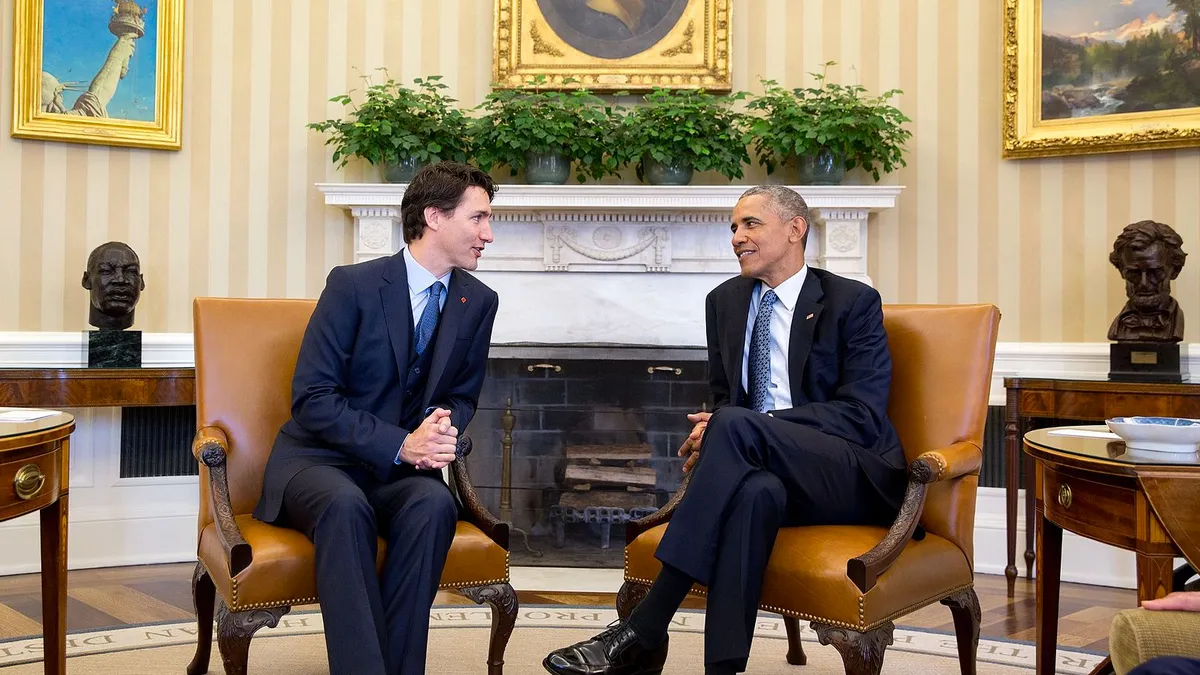Correction: An earlier version of this post indicated the 50% renewable energy goal applied to each country individually. That was incorrect. The 50% renewable energy goal represents an average of the power mixes of the three nations. The corrected post follows.
Dive Brief:
- The United States, Mexico and Canada have struck a new regional deal to produce 50% of their combined electricity by 2025 from clean energy sources, including wind, solar, nuclear and hydropower, Reuters reports. The agreement is set to be announced Wednesday at a summit of the three nations.
- The deal builds on a slate of climate efforts from the Obama administration, including the EPA Clean Power Plan and signing of the Paris Climate Agreement last year. The CPP, currently under a judicial stay imposed by the Supreme Court, will be necessary in meeting the 50% goal, the White House said.
- Currently the three nations average 37% renewables and nuclear energy. The deal is most ambitious for Mexico, which got less than 20% of its electricity from renewables and nuclear last year. The U.S. currently sources about a third of its power generation from renewable and nuclear resources, and Canada is over 80%.
- The agreement also includes language to limit methane emissions 40% to 45% by 2025 and provisions to ease power trading across borders.
Dive Insight:
The pledge represents the latest in the Obama administration's efforts to solidify a transition to a lower-carbon energy system at home and abroad.
Last year, the U.S. EPA finalized its Clean Power Plan, which aims for a 32% reduction in power sector carbon emissions by 2030. Even if it survives a legal challenge from fossil fuel interests, analysts expect more policy measures will be needed to help the U.S. do its part in meeting goals under the Paris Climate Accord, which seeks to virtually eliminate man-made greenhouse gas pollution by the end of the century.
This latest three-nation agreement is a step in that direction, seeking to provide additional policy certainty for the clean energy sector in the next decade. Under the deal, the three nations would agree to produce half of their combined electricity from non-fossil fuel sources like wind, solar, nuclear and hydropower by 2025.
The deal is likely to open new power trading opportunities for Canadian utilities, which got 81% of their power last year from renewables and nuclear, according to the CBC. The agreement includes provisions to ease the procurement of power across international borders, and power providers with excess clean energy could help others bring up their supplies.
The transition is set to be most dramatic for Mexico, which got less than a fifth of its power from non-fossil resources last year. The nation is in the midst of privatizing its electricity sector, with the state-owned power agency selling off generation assets and opening new market opportunities for independent suppliers.
For the U.S., the change is set to be less dramatic. The Energy Information Administration projects renewables and nuclear would deliver a little over 40% of U.S. electricity in 2025 if the Clean Power Plan is upheld, and 38% if it is overturned in court. Acceleration in clean energy adoption and enhanced Canadian imports could help the U.S. meet the 50% clean energy mark.
Nuclear generation is one area that could challenge U.S. compliance with the deal. Responsible for a fifth of total U.S. generation today, many nuclear plants are struggling to compete in the nation's organized markets as cheap natural gas and stagnant load growth keep energy prices down. Last month, Exelon announced it would retire two struggling nuclear plants after a support package failed to pass in the Illinois legislature, and utility executives are calling for market reforms to preserve remaining plants.
The climate accord did not limit itself to carbon. Mexico would also sign on to provisions agreed between Canada and the U.S. last year to cut methane emissions by up to 45% by 2025. Methane is a greenhouse gas more than 20 times more potent than CO2 in the short term and environmentalists say addressing leaks will be crucial in ensuring a shift to more gas generation does not impede climate progress.













